Is Elrond Network The Future Smart Contract Blockchain Market Leader?

- Distributed Ledger Blockchain Technology Represents an $867 Trillion Dollar opportunity per the World Economic Forum.
- A world class simple and intuitive end user application, Maiar, to finally allow for critical mass adoption, similar to the internet browser breakthrough for the internet.
- Elrond Network’s Secure Proof of Stake is the most significant breakthrough for energy efficient POS consensus mechanisms. Allowing for fairness of all network participants and avoiding pooling of resources.
- Elrond Network’s Adaptive State Sharding allows for a 1,000X improvement in performance and is the only infinitely scalable Layer 1, 3rd generation Blockchain. Scaling to 100,000’s TPS as demand increases.
- A world class team of entrepreneurs, researchers, engineers, led by CEO Beniamin Mincu with endless drive and business savvy to facilitate critical mass adoption.
*Disclaimer: The Content is for informational purposes only, you should not construe any such information or other material as legal, tax, investment, financial, or other advice.
To help people navigate the content of this research report and investment thesis, I have created a visual outline.
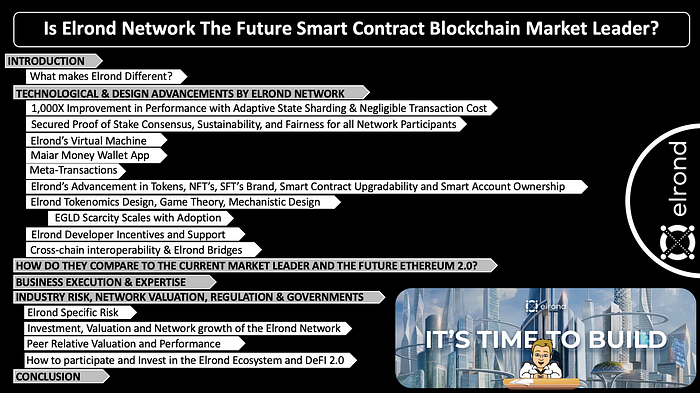
INTRODUCTION
The internet came prior to having infrastructure that would allow true ownership of our digital assets and data. Yet our world is continually becoming more and more digital. This has led to heated debates in front of congress as to the centralized power vacuums that continue to accelerate for the most powerful companies in the world with sole control over most digital assets and data. Most individuals can’t even conceptualize what owning or even monetizing on their own data would be like. Distributed Ledger and Blockchain technology create the infrastructure to allow for a more equitable share of digital assets and data ownership, which can be owned by individuals not just a few companies, with centralized servers and power.
Our existing outdated Financial Legacy system appears predatory. In fact even recently JP Morgan extracted $1.5 Billion in overdraft fee’s. This is more than Coinbase’s entire revenue at $1.3 Billion. JP Morgan posted a record $12.1 Billion in profits. Logic would lead us to believe that the poor were the one’s having their accounts over-drafted, the people who could least afford it. This was even after they were instructed to stop overdraft fee’s during one of the most draconian economic humanitarian crises the world has ever experienced. Around 40% of the world doesn’t have a bank account. An acceleration of smartphone adoption around the world over the next decade is expected. What stands in the way of critical mass adoption of mobile banking services for everyone is a highly scalable, fast, secure blockchain with negligible fee’s and proper mechanistic design to allow fairness for all network participants. All things considered, the worldwide economic multiplier effect may be drastic as such a large portion of the world is able to participate for the first time.
When the World Economic Form publishes a report that states the opportunity for disruption by blockchain or distributed ledger technology is around $867 Trillion (Link,Link). I think it’s noteworthy that every investor should at the very least start to become educated in the area. While the timeline for how long this takes is anyone’s guess I think it’s worth pointing out that the internet and our interconnected world is ripe for things to happen faster than imaginable or experienced in the historical past. If you combine this with a worldwide crisis in trust and an outdated financial legacy system, it may accelerate change.
Cryptocurrency and blockchain technology adoption is still very much in its infancy. It’s estimated that only 2.8% of the worldwide population owns cryptocurrency as of 2021. The label of “currency” may be the greatest deterrent for most analysts, investors, or people unfamiliar with the space. Digital property or technological assets that may also be used as a direct medium of value exchange is a more appropriate framework of understanding.
While there has been endless discussion and debate around Bitcoin in particular, to a lesser extent focus on smart contract emphasized blockchains such as the current market leader Ethereum. Many believe Ethereum’s stronghold in its current position due to first mover advantage, adoption, liquidity, and developer community will secure its future as the market leader but is this the case?
In a space dominated by theoretical ideas, marketing hype, speculation, outright fraud at times, delays or missed deadlines & false hope, there appears to be a project that is poised to be the future market leader in the smart contract blockchain space by bringing groundbreaking value through its world class team, technological breakthroughs, unparalleled execution, intuitive & simplistic user interfaces. Finally, allowing for mass adoption and attracting the best Decentralized Applications (DAPPS) due to performance, negligible cost and a best in class 30% royalties paid to developers. The project see’s itself as lifting all tides not necessarily as an “Ethereum Killer”. While there are many theories as to how many smart contract blockchains will exist in the future, I fall into the camp that there will be multiple.
Elrond Network is a highly scalable, fast and secure blockchain platform for distributed apps, enterprise use cases and the new internet economy. The two primary objectives is to build the backbone for a high-bandwidth, low latency, transparent architecture that enables a different type of economy. Elrond Network is trying to extend this opportunity to anyone, anywhere around the world through its best in class simple & intuitive user interfaces. It has been likened to the “Apple” of the smart contract blockchain space because of this, by early adopters. Elrond takes away the underlying complexity of public blockchains, making building and using applications on the network a familiar experience to users, developers, enterprises, financial firms, and more.
WHAT MAKES ELROND NETWORK DIFFERENT?
What makes Elrond different is their top team members who have extensive experience in the blockchain & cryptocurrency space. When it comes to disruptive technology often times the first creator or experimenter rarely ever is the future market leader. Why? It’s because essentially the beginning years of the technology is likened to a science experiment where you are testing out what is possible and exploring new frontiers. It feels like you are the future but typically 1st Generation & 2nd Generation don’t become the market leader but they may continue to be successful in their own right.
The first principle design architecture may lend insight as to why 3rd generation technology may become the future market leader of the smart contract blockchain space. This is because the initial design architecture of 1st generation and 2nd generation blockchains was limited as it wasn’t able to account for technological advancements that were yet to be discovered or understood. The trilemma in the blockchain space is at the foundation of architecture design, which involves security, decentralization and scalability. Elrond Network leveraged the team’s expertise, years of in depth experience, and designed a first principle architecture unlike anything the space has seen.
Elrond’s top team members and co-founders, includes Beniamin Mincu CEO, Lucian Todea, COO and Lucian Mincu, CIO. They have been in the blockchain and cryptocurrency space since 2013. They have worked on and invested in many projects attempting to solve the issues that have prevented mass adoption. After 4 years they realized that no one was nailing it from all angles. Elrond is not just another smart blockchain project. They assembled a team of experienced entrepreneurs, engineers and researchers with significant blockchain and technical experience backgrounds from Google, Microsoft, Intel, NTT DATA, MITT, IBM and others. Backgrounds in Computer Science, Blockchain, Design, Space Exploration, Artificial Intelligence, and World Math Competition Awards. The team includes two PhDs in Computer Science & Artificial Intelligence, multiple math, CS, and AI Olympiad champions, and a former member of the NEM core team. Essentially, a team with the ability & capacity to build rockets.
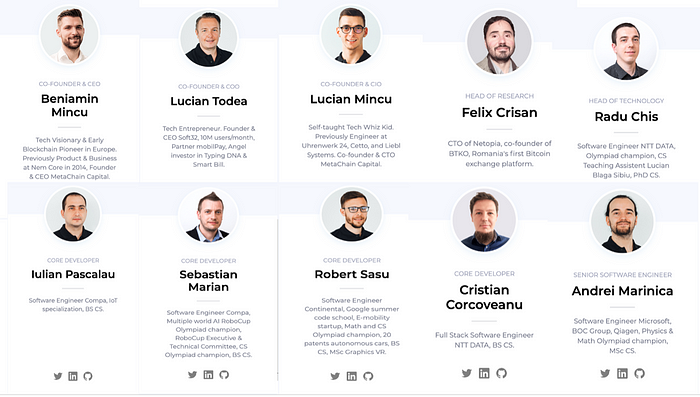
Elrond created a brand new blockchain from line code 1. This is in stark contrast to most projects or other blockchains caring only about speed to market or incremental innovation. Most Blockchains do not start from code line 1. Many blockchains or projects are forks or borrow design elements from others but never completely rethink things. In order to bring 1,000X improvement everything needed to be re-imagined as incremental innovation wasn’t going to work. This was at the foundation of Elrond Network’s architecture and technological advancements. This was made possible because they dissected, scrutinized, and were involved in the Blockchain space as developers & investor since 2013.
They learned what was working, what wasn’t and took on the monumental endeavor of solving all the issues. It should be pointed out that this team is very committed and passionate, it shows based on their world class execution and progress which is rare in the development world. Almost all of their lead engineers and developers push 24 hour + shifts at times. Over the span of 3+ years they have performed a half million hours of development and 1.5 million code lines. This has allowed them to bring design architecture and technological advancements that are entirely new to the space.

Elrond Network is the only infinitely scalable Layer 1 Blockchain that can dynamically adjust for the needs of the network by adding or taking away shards. When you combine this with their significant technological advancement, secured proof of stake, this dynamic adjusting of the network doesn’t compromise security; maximizing efficiency, scalability, decentralization and allowing for the most energy efficient blockchain to date.

TECHNOLOGICAL & DESIGN ADVANCEMENTS BY ELROND NETWORK
The technological advancements that Elrond Network was able to achieve through its ground up blockchain re-design is nothing short of groundbreaking. It’s important to note that they did this without compromising security or decentralization. Many high TPS Blockchains compromise on security or decentralization, essentially not solving the complete picture, solving the trilemma, preventing long term sustainable success. Below is a breakdown of the key advancements that have been achieved:
1,000X Improvement in Performance with Adaptive State Sharding & Negligible Transaction Cost
While extensive research in the blockchain has been done on sharding, most have chosen other options that are less complicated to allow for scaling to higher transactions per second. Sharding is not a blockchain invention, it’s a concept that has been implemented as a method for horizontally partitioning databases. The performance advantages are extensive, along with storage savings. Elrond implemented three types of sharding in order to allow for dramatic increases in performance through parallel processing. The three types are State Sharding, Transactions Sharding, and Network Sharding. The adaptive state sharding combines all three synergistically to allow for improved communication inside the shards.
The reason for implementing all three Sharding techniques was imperative for long term success. Elrond chose not to just do Network Sharding and Transaction Sharding but to solve the most difficult of the three, State Sharding. This allows the problem of scalability, to no longer be a limiting factor and all the focus can be directed towards building DAPPS that will bring value that supersedes the existing centralized apps.
The difference between Network & Transaction Sharding vs State Sharding translates into a difference in only Sharding on transactions, which means you can process in terms of scale at 2,500 transactions per second if it were payment transactions but you cannot scale transactions to the same level if they are smart contracts. For example, Zilliqa can process 2,500 transactions per second if they are payment transactions but cannot scale to that for smart contract transactions as they do not support scaling at that level as they don’t use State Sharding. In order to get to a place where you are not thinking about scalability all three must be solved. State Sharding is by far the most difficult.
This breakthrough has allowed for 1,000X improvement in transactions per second. Ethereum currently can process 15 transactions per second vs. Elrond’s 15,000 transactions per second. This can be infinitely scalable as demand of the network increases in an adaptive way to maintain efficiency. Elrond demonstrated a 263,000 TPS in their testnet (Link, Link). This allows for a significant reduction in cost per transaction. Cost per transaction becomes negligible at $0.001 per transaction in comparison to Ethereum which is $10.20 per transaction and has been seen to be as high as $800+ during high traffic times.
Ethereum the existing market leader has been heavy into research as to how to best scale their blockchain. They have chosen to go with sharding as well after much research which can be seen here being discussed by Vitalik: It should be noted though that Ethereum 2.0 or Serenity plans to only implement one type of sharding. This is due to their architecture limitations and the resulting security. They will have a maximum of 64 shards at 50 transactions per second per shard, meaning the maximum scalability is 3,200 transactions per second. This is why Polygon will be continually needed to allow for scalability beyond those numbers. The drawback is less user friendliness due to more steps, complexity, and it being less secure.
Secured Proof of Stake Consensus, Sustainability, and Fairness for all Network Participants
There has been much debate about consensus mechanisms. With debates discussing what is superior, proof of work vs proof of stake. Bitcoin and Ethereum currently use proof of work. The issues with this consensus mechanism is that its very energy intensive, which has been the primary reasoning for Elon Musk and Tesla to stop accepting Bitcoin as payment.
The advocates state that by requiring “work” to be done, via computational effort its the best method to maintain security of the network. BTC Proof of Work Economic model is where a miner takes everything (block reward + transaction fees), there is only one way to improve your chances of being successful: increase your hash power. This leads to three outcomes: i) it becomes uneconomical for small/low power devices to participate, ii) mass pooling of resources becomes desirable, and iii) specialization of hardware becomes necessary. In contrast, Proof-of-Stake (PoS) does not rely on rewards for securing the network, but rather on penalties. Validators put money (“security deposits”) at stake, and are compensated for locking up their capital and incurring costs for maintaining the node. Most of the cost of acting against the rules comes from penalties that are hundreds or thousands of times larger than the rewards an attacker could get in the meantime. So if in PoW the miners are competing with each other, in PoS validators are collaborating with each other. In this way, a PoS network allows for a much more resource-efficient, scalable, and inclusive way of maintaining a permission-less blockchain network.
The downside of existing proof of stake models is that they may also cause pooling of resources, essentially rewarding the validators with the most staked, leading to centralization. This is where Elrond’s breakthrough of “Secured Proof of Stake” is best in class. This is done by combining eligibility through stake and rating with random validator selection, and an optimal dimension for the consensus group. The Byzantine Fault Tolerance (BFT)-like consensus protocol maintains a high security level through random sampling of the consensus group and random reshuffling of nodes into other shards. The consensus uses an unbeatable randomness source generated by the block proposer via signing the previous random source. This resets after each block. The chances of nodes being in the same consensus group are lower than winning the lottery thus do not have the capacity to coordinate maliciously. With that said if for any reason any malicious intent was detected, nodes are then jailed. Observer nodes keep a history of the blockchain, keeping validator node storage requirements low. Also, Fisherman nodes (not in consensus round) challenge blocks to ensure no malicious actions are taken.
This is imperative for allowing optimized security and laying the foundational groundwork for fairness for all participants on the network by not incentivizing pooling of resources and centralization. Looking at the numbers gathered in early PoS networks and the two largest PoW networks (Bitcoin and Ethereum), we can see that the money spent on infrastructure is an order of magnitude smaller in PoS compared to PoW (around 10% of the rewards instead of 100%). Running a Validator for the Elrond Network is economical and low cost, promoting inclusiveness and decentralization as a normal computer specs is all that is required 2CPU, 4GB RAM, 80Gb HDD, 100Mbit.
With Elrond there is no mining. Instead, validators earn tokens for doing useful work. One of the strongest value propositions that Elrond created was designing a Network achieves guarantees of fairness for all the network participants. In the case of validators, Elrond was designed to be resistant to concentration of resources and to ensure an equal and fair distribution of rewards based on the work done by all validators, whether big or small. This ingenious design can’t be understated considering the primary ETHOS of public blockchains was born out of the desire to promote decentralization and equitable opportunity.
PalmTree led by Jose Aznar one of the staking providers for the Elrond Network summed up the significance of the Secure Proof of Stake model. “Secure Proof of Stake is one of the most innovative additions the Elrond team has made to the industry. A lot of first generation PoS based protocols think that security relies on the more stake a masternode possesses, the more blocks it validates. However, this creates a real concentration of power in the first masternodes. That means if one of the big masternodes fails, the network may face security problems. We love the sPoS approach because all of the nodes in the network will validate the same quantity of blocks. Several random selection functions get mixed in addition to reshuffling nodes between shards. This statistically makes it really hard to attack the network. And its design increases (in parallel) decentralization, security, and speed,” he said.
Elrond’s Virtual Machine
The Arwen Virtual Machine allows for dedicated smart contract execution built on WebAssembly (WASM). The advantages are significant. The speed differences compared to Ethereum’s Virtual Machine (EVM) allow for compiling a large volume of code very quickly which is impossible for EVM. This enables faster load times and an increased number of transactions per block, thus maximizing speed and scalability. The flexibility of the Arwen Virtual Machine allows for diverse compatibility with languages available such as Rust, C/C++, C#, and Typescript, which allows developers to write smart contracts in whichever language they are familiar with, compile it with WASM and easily debug its WAT into human readable format. This promotes interoperability of several different languages.
The Arwen VM executes code using Wasmer as an execution engine, which operates as a just-in-time streaming compiler. Due to the design of Wasmer, the smart contracts are executed at near-native speed. This is very unusual as typically the transactions per second advertised are significantly slower when combined with smart contracts, something that shouldn’t go under-emphasized. Also, The Arwen Virtual Machine has achieved something other sharded blockchains have not, the ability for the Arwen Virtual Machine to function between shards, which is a significant breakthrough that has been unachievable by others. Elrond’s virtual machine is all around the most advanced in the entire blockchain space. These advantages will allow decentralized applications that were limited by technological limitations to come alive.
It’s worth noting that Ethereum has chosen WebAssembly for when it upgrades to ETH 2.0, EVM to eWASM. The overarching theme is much of what Ethereum 2.0 will be is not only live today on the Elrond Network but superior to what the finished product of ETH 2.0 will be at the end of 2022 from a technological standpoint.
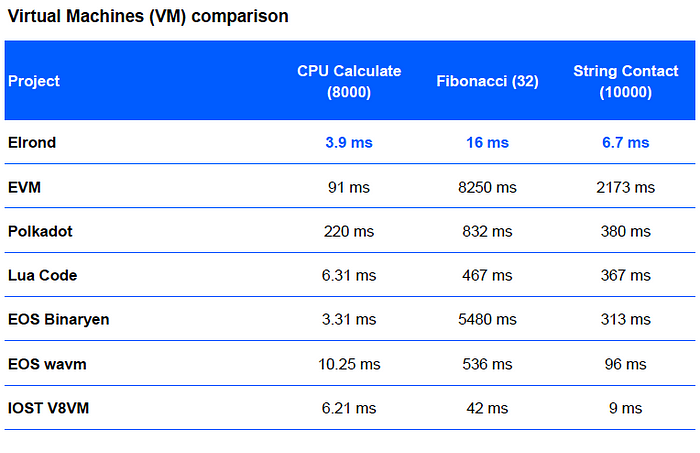
Maiar Money Wallet App
One of the primary reasons that has prevented critical mass adoption in the blockchain distributed technology space has been the extreme complexity of the user experience. Developers at times can forget that while the technology is important with respect to the value propositions it allows for, the end user shouldn’t need to receive hours of training to use it. Developers though are notorious for at times accentuating this to a fault for their own personal reasons at times (sadly) or technological limitations. This in someway goes against the principles of what the ETHOS of blockchain and distributed technology was designed to help with. A recent video by RektTV best sums up the importance of this, “Let’s not build more experiments for the experts, but instead create tools that welcome newcomers, that invite them in and provide a better future that empowers us all.”
Elrond’s team has created a wallet that removes friction of the end user on-boarding, through leveraging progressive security and simplicity. A phone number is all that’s needed initially. It’s designed with the idea that even your grandmother or grandfather could use it. The Maiar Wallet allows for sending money to be as simple as sending a text message, without the need to use long cryptographic public address keys. The Maiar Wallet is a non-custodial Wallet which means you have full control over your money and account, much of the value proposition early adopters have been incentivized by. No one can access your funds, except you. Here is a video showing the ease of use and beautiful user interface.

Meta-Transactions
The existing internet usage has promoted a culture of free to use. Meta-transactions cost & thus may impair the adoption of DAPPS building on smart contract blockchains. While Elrond has one of the industry’s leading low cost transactions if someone has to pay anything it increases friction of adoption and usage. Maiar leverages Meta-Transactions which are blockchain transactions in which a user can execute without owning cryptocurrency.
The creation of a Herotag when on-boarding to Maiar is an example of a Meta-transaction which allows for anyone to send money simplistically, instead of using a long public address. This allow’s for social payments and interaction, which is powerful in its own right. This allows for one to not have to share their phone number and still receive and send payments. From the user’s point of view, sending a meta transaction is similar to sending a regular transaction — it needs a destination address, amount of EGLD or tokens transferred, and any input data required by the context. The only difference is that a relayer will pick up this transaction and pay the associated gas costs.
Meta-transactions have deep implications for blockchain technology adoption. Unhindered by fees, paperwork or waiting times, users have the freedom to explore the full breadth of blockchain opportunities at an internet-scale. Surprisingly, this subtle feature may feel common sense to normal web users, but using blockchain technology through these uniquely powerful UX improvements opens up a massive addressable market for developers and the Elrond Network’s own suite of product developments to support growth.
Businesses and developers looking to onboard new users to their blockchain based applications will likely use this to remove friction. Public administration and governments looking to offer secured services to their citizens for free. The industry leading 30% royalty fee’s that Elrond has built into the smart contract will allow businesses to subsidize the cost of acquiring new users, which is such a small amount considering the low fee’s of the network. This has vast potential use-cases such as decentralized finance, entertainment, commerce, administrative scenarios and much more. As you can see Elrond has strategically tried to remove all barriers or friction pain points that prevent mass adoption. This is critical in the success of the network and the appreciating value that will accrue to EGLD its native token.
Elrond’s Advancement in Tokens, NFT’s, SFT’s, Brand, Smart Contract Upgradability and Smart Account Ownership
Elrond has made considerable technological advancements with respect to custom tokens that are issued on the Elrond Network by Developers. These custom tokens are similar to Ethereum’s ERC-20 custom tokens but with significant technological improvements. They are called Elrond Standard Digital Tokens (ESDT) which can be issued by developers.
The custom tokens are as fast as the native coin EGLD that powers all transactions on the network. The balance of the tokens are stored directly in the user’s smart account not tied to the smart contract. Elrond has an associated data trie, which enables any account to have key-value storage where balances of any number of tokens can be stored. The ownership is tied to the account and not a 3rd party smart contract. The implications of this are powerful from a legal, economical and psychological perspective. The tokens are manageable by the account and smart contract. Also, the smart contracts are upgradeable which has significant implications for developers. All of these ESDT are powered by the high throughput, low latency and negligible fee’s of the Elrond Network.
A token issued on Elrond does not need its own smart contract, which greatly reduces its storage footprint and cost. Another important implication is that a token transfer transaction does not need to be processed by the Virtual Machine. Increases the transfer speed and reduces the gas requirements down to just the regular TX cost + storage fee for the additional bytes of data in the data field.

Elrond’s NFTs (Non-Fungible Tokens) are ESDT’s with additional metadata. This metadata induces royalties information that allows the creator to receive royalties for any transaction involving their NFT. This is powerful as it paves the way for true NFT ownership. Ethereum’s NFT ERC-721 standards assigns ownership on the token’s smart contract not the account. Also, Ethereum’s NFT’s are platform specific, thus if purchased on one platform and sold on another the artist or author will not receive royalties.
The Elrond NFT standard solves this with built-in royalty fee in the protocol. This is essential in giving more power to every artist, author and creator. Also, Elrond has created the ability to register an NFT brand at $0.20, where there is no such equivalent on Ethereum. The cost to create an NFT currently on the Ethereum network is anywhere from $100 to $600, which is significantly different than $0.01 to create an NFT on Elrond. Also, to transfer an NFT it costs only $0.01 vs. $100 on Ethereum. Elrond Network strategically plans to do a first invite only with top artists from around the world.



Elrond Tokenomics Design, Game Theory, Mechanistic Design
The Blockchain must also account for the economics, incentives of all participants & thoroughly understand Mechanism design, a subfield in game theory, often referred to as reverse game theory, because one must start with a desired outcome in mind, and work backwards to design a game promoting it. A game where rational self-interested players will produce a desired outcome. It’s easy to unintentionally design in the thought process or context of a vacuum thus accounting for actions but not interactions of participants which unintentionally allows one participant to have a pooling of power & resources not allowing for an equitable distribution & access of opportunity to all network participants. Elrond Team has the best Economic Incentive Mechanistic Design Models of any project. The breadth & depth they think through things is so powerful because it accounts for the whole picture, considers all perspective/parties/participants & creates sustainable long term value for all network participants.
The Elrond tokenomics are designed in a very unique way. Its native token EGLD has a fixed supply equal to Pi.

This is equivalent to roughly just over 31 million to ever exist, but the design elements allow for the token to likely never reach its maximum. Every year there is a fixed supply minted for validators. As adoption increases and the volume of fee’s on the network that are collected supersedes the inflationary minting of rewards required to pay validators, inflation stops. This really aligns the incentives to push for adoption. The visuals below helps one to understand this genius design.

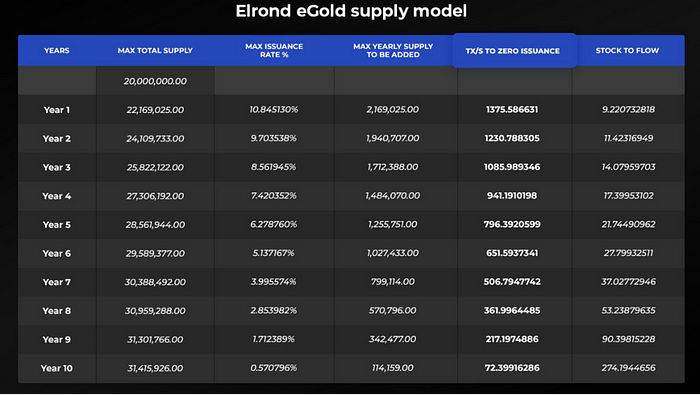
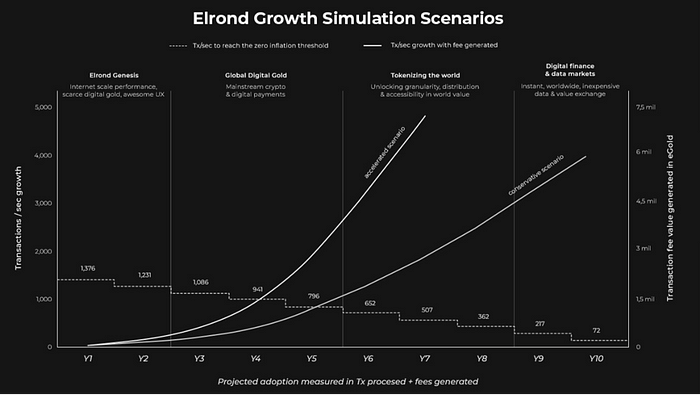
This tokenomics model not only creates aligned incentives to make strategic decisions for adoption but unlike many existing models allows for long term sustainability. As more and more DAPPS and modular features are built out on Elrond, EGLD holders essentially share in the network fee’s forever through increased volume of transactions, in combination with the increase in asset value as more DAPPS are built on the Elrond network. This is very powerful and one of the many reason for personally feeling very comfortable investing in EGLD and the Elrond Network. Many tokenomic design models mint through inflation or mining but don’t have a long term sustainable approach as to how the security of the network will be maintained and value will be delivered back once the inflation or mining stops. EGLD essentially combines the scarcity of Bitcoin with the programmability of Ethereum, and a very strategic long term value delivery capture to its holders through network fee’s while the fee’s are so minimal due to the technological advancements discussed above, aligning all network participants with a win-win proposition. This allows for an incredibly powerful feedback loop of deflation, asset appreciation via DAPPS and yield return through network fee’s.
EGLD Scarcity Scales with Adoption
Every transaction on the Elrond Network reduces the inflation and insures that EGLD will never reach its theoretical supply of 31.4 million. This economic model is extraordinarily genius as adoption increases, transactions increase, amplifying its scarcity by reducing supply, increasing price, which further drives demand to share in those network fee’s by staking, further amplifying scarcity, in a perpetual loop. All of this is backed by a state of the art technological infrastructure where DAPPS will drive asset appreciation and further adoption, all magnifying price appreciation and value returned to EGLD holders. The technology is important but most Blockchains don’t understand that the economics may be the determining factor for long term success and sustainability. Elrond has the best in class tokenomics, hands down. In a recent film discussing about Blockchain’s disruption, the extreme importance of this topic came up here.
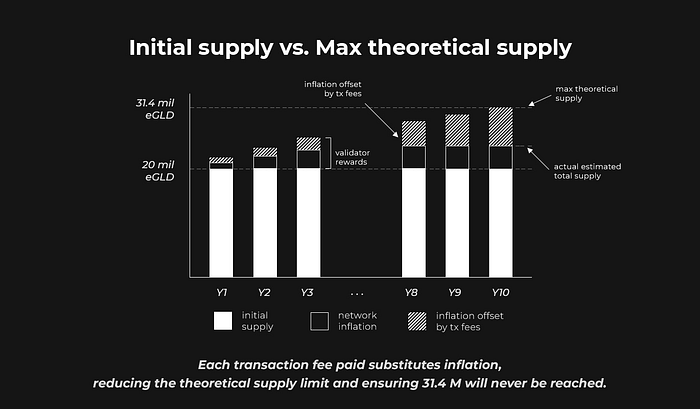
The money properties of EGLD are below visually represented.
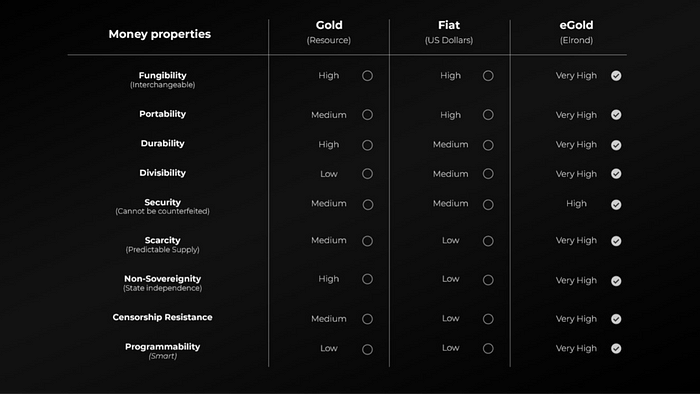
There has been discussion around concentration of EGLD in the top wallets on a few communication mediums. While this information has been debunked by community members which can be seen here. It’s worth noting that in a recent interview, Beniamin Mincu, discussed the team was proactively in the works of finding a way to label those wallets on the Elrond Explorer with the appropriate exchange names that they belong too, in order to diffuse any false rumors. The concentration of EGLD within those wallets are simply due to exchange listings, that deal with hot and cold wallets.
Elrond Developer Incentives and Support

Many of the technological advancements discussed above will incentivize developers to build on Elrond Network such as:
- Blockchain Infrastructure (security, speed, low cost, decentralization, scalability, sustainable economic design for all network participants)
- Smart Contracts (30% gas as royalties, fast small, composable and upgradeable)
- Smart Account (ownership & functionality)
- Tokens and Transactions (low transfer fee’s, meta-transactions, true token ownership)
- Arwen Virtual Machine — best in class.
- Multiple contract language support
- With now over 607,000+ users this will further incentivize developers to build on Elrond Network

Below is the Eco-system adoption map that is currently building on Elrond Network.
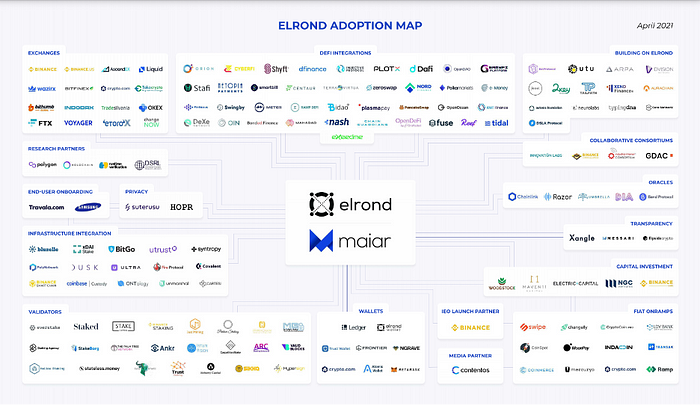
Cross-chain interoperability & Elrond Bridges
One of the elements that continues to plague much of the blockchain distributed technology space is the lack of interconnectedness or interoperability. It’s imperative to create cross-chain communication and transactions to allow for less fragmentation or islands. Elrond allows for communication between chains for secure cross-chain transactions without the need for exchanges. This permits unlimited communication with external services. Elrond’s ecosystem strives for interconnectivity, the solution for smart contracts offers an EVM compliant engine to ensure interoperability by design.

Elrond’s Bridges enable the transfer of tokens from one chain to the other without the need for centralized exchanges, as well as the interaction with other smart contracts as discussed prior. The bridges are key for enabling liquidity to flow seamless through the Elrond Network, allowing any project the opportunity to leverage Elrond’s state of the art high throughput, low costs transactions and simplistic user experience.
HOW DO THEY COMPARE TO THE CURRENT MARKET LEADER AND THE FUTURE ETHEREUM 2.0?
Ethereum is the current smart contract market leader with security and decentralization sufficiently nailed down but not scalability. They have been in the works of attempting to scale for many years. It’s worth noting that execution has been far from Ethereum’s strong suit, with meme’s showing Vitalik (Ethereum’s founder) finally revealing ETH 2.0 at an old age. They were scheduled to release ETH 2.0 or Serenity, later this year, leveraging sharding, a scaling technique. With that said, just recently announced now it won’t be until the end of 2022. It appears that Brook’s Law which deals with software project management is playing out, “adding manpower to a late software project makes it later”. The false promises have been occurring since 2017. This isn’t an opinion it’s a fact. Ethereum has continually stated ETH 2.0 would be here but has failed to deliver. Execution is poor while Elrond’s execution is superior to all smart contract Blockchains in the space. No one has been able to execute in the speed & quality of Elrond. Most of what has been promised by others is live today. Also, they are very strategic in their sequential execution which is imperative for long term success.
Unfortunately, Ethereum’s initial design architecture limits the maximum transactions per second (TPS) or throughput it can mange on the main-chain to 3,200 TPS. This can be calculated based on a maximum of 64 shards at 50 TPS is equal to 3,200 TPS as discussed earlier. The Visa Network can process upwards of 55,000 TPS.
This architecture design limitation is why earlier this year they partnered with Matic now rebranded as Polygon, among others, which allows for scaling way beyond those numbers thus reducing the limitations of their first principle design flaw. It wasn’t a flaw per se as much as it was a limitation of understanding in terms of being able to create a truly complete foundational architecture solving the trilemma (Security, Scalability, and Decentralization). While this may sound like the perfect solution it certainly doesn’t come without its drawbacks or added complexities.
Polygon/Matic among others have rushed in to prove Layer 2 scalability solutions. Unfortunately, these solutions create complexity on User experience, adding multiple steps/transactions & increases risk of user problems (ie sending from Layer 2 to a non-Layer 2 compatible platform (funds are lost). Also, it brings into question security, while MATIC has mitigated this it still is not perfect. The security mitigation strategy used is best explained in a recent video discussing the concept of a commit chain vs. side chain.
Elrond solves Ethereum’s largest problems both today and when Ethereum 2.0 goes live it will still be superior due to its design architecture & significant advancements in technology (ESDT vs ERC-20, NFT’s, SFT’s, Smart Account Ownership), 30% built in royalties for Smart Contracts to attract the best developers, infinite scalability, 1st principle design architecture solving the trilemma, low cost barrier to entry validator node requirements, team execution, careful mechanistic design and economic incentives to create fairness for all participants on the network & best in class tokenomics.
Ethereum’s tokenomics are unlimited (inflationary) & while EIP 1559 proposes a burn to create scarcity it certainly is far from perfect or great. Elrond on the other hand has 31 Million fixed, with 17.4 Million outstanding & the minting is stopped entirely if the network adoption supersedes the inflation, as discussed in more detail above.
Ethereum 2.0 or Serenity is inferior even though not live today in comparison to the first & only live blockchain architecture with adaptive state sharding. Elrond network is the first to present a viable solution where all the three aspects of sharding — state, network and transactions — have been implemented at once. Combined with its “Adaptive” component, this novel architecture allows for dynamic network configuration to maintain a high level of security while scaling with demand. Ethereum 2.0 will have no adaptivity with consideration on the main chain but will in use a myriad of other scaling solutions that call into question elements that are difficult to model from a network risk standpoint.
Ethereum 2.0 looks to use POS instead of POW but POS requires novel design in order to optimize fairness for all network participants and the highest level of security. Elrond approaches the consensus problem with a mechanism called Secure Proof of Stake as discussed in detail above, which mitigates potential attack vectors when compared to Proof of Work, while also enabling large throughput, fairness for all validators and fast execution.
Elrond is poised to attract the best developers with both its high performance but more importantly industry leading built in 30% royalties to all DAPPS. The wallet difference of Maiar vs. Metamask will position itself with a higher likelihood of critical mass adoption. The team has built out a standard developer kit (SDK) to allow new Dapps to leverage the Maiar app through its one click connect feature. Every functionality and design element is thought about simplifying the end user experience. The everyday individual can now easily stake, participating in securing the network and share in the long term network transaction fee’s (video). The importance of user experience and simplicity can’t be overstated for critical mass adoption to occur. The end user experience needs to graduate past it being required to understand what’s going on vs. not needing to know (think the internet browser moment for the internet).
Business Execution and Expertise
This should not go underemphasized. When it comes to a groundbreaking technology flourishing, it can’t do so on its own. It requires education, marketing, world class communication, partnerships, collaborations, and incredible user interfaces that we have discussed in depth. Elrond is led by Beniamin Mincu who I believe may be one of the best assets to the success of Elrond Network. He is relentless in his ability to create connections and foster new relationships that will further the expansion and opportunities for adoption for the Elrond Network.
“It’s easier to say things than do them” — Beniamin Mincu
Beniamin Mincu has been fostering a close relationship with pro-crypto enthusiast Mayor Francis Suarez of Miami. He has met with him on multiple occasions.


Mayor Francis Suarez appears very much in support of helping with the expansion and adoption of the Elrond Network. There has been speculation discussing the possibility that they may in fact utilize the high speed and low cost capabilities of Elrond network to pay the workers of Miami in Bitcoin.

Beniamin Mincu over the last number of years have facilitated media appearances in the following, Forbes, Inc., Bloomberg, Yahoo Finance, The Block and others.
Recently Elrond Network was able to solidify a key partnership and commitment from Audi backed start up Holoride to build on the Elrond Network. Holoride turns vehicles into moving theme parks, through hyper-immersive experiences by combining navigational and car data with Extended Reality (XR). They have stated they will use the Elrond Blockchain technology and NFTs as a way to incentivize developers to bring more content to its in-vehicle XR experience.

I anticipate Beniamin Mincu to continue to foster and cultivate many strategic and valuable partnerships with existing businesses, governments, individuals and startups. All of these will facilitate the adoption and growth of the Elrond Network.
The marketing videos produced by Elrond Network are incredibly powerful and captivating. Beniamin Mincu is an incredibly deep and strategic visionary. He ensures to push the team and Elrond Network with incredible speed and progress but never at the expense of making mistakes. The plan is for the long term, with strategic decisions accounting for the next decade and further.
Industry Risk, Network Valuation, Regulation & Governments
Investing in Smart contract Blockchains comes with substantial risk. Investors need to consider the complexity of the interwoven mediums of expertise required for success. Essentially they are attempting to be successful by navigating the following elements which is no simple task.
- Start Up’s (Forbes over 90% fail 2015)
- Experimental Disruptive Technology
- Game Theory & Mechanistic Design
- Economics & Financial Markets
- Governance & Behavioral Incentives
- Programmable Money
- User Experience & Design
- Networks
All facilitating and contributing to the disruption of the most powerful entities & industries in the world:
- Financial Sector(Banks/Mortgages/Insurance, derivatives, exchanges, payments)
- Supply chain/Logistics
- Art & Entertainment
- Content delivery
- Big Tech (Decentralized Social Media & Video)
- Politics/Government
- Financial Sector (Currency/Forex)
- Transportation (Decentralized “Uber”)
- Digital Gaming, Sports Betting, Casino & Lottery
Decentralized Autonomous Organizations (DAO) are all in a grey area of regulation but due to being decentralized, theoretically can’t be stopped without the shutting down of the internet, at least from an enforcement perspective. While governments have attempted and failed to stop its progression in many countries, it’s a delicate balance. I believe we are entering a period where governments will make or break the economical fate’s of their nations due to the $867 Trillion economic disruption opportunity recently reported by the World Economic Forum discussed in the introduction. If governments overtax or are unsupportive of these technological advancements other countries, in worst off positions will likely rise above them due to efficiencies that will arise. Governments and Nations willing to promote, encourage, and foster the disruptive technology will likely attract citizens of prosperity, increasing economic activity. Also, efficiencies and enhanced trust arising from the implementation of blockchain technology may be something we have never seen among government spending and accountability.
The blockchain could provide governmental accountability through transparency giving way to symmetry, a concept often discussed by world renowned author Nassim Nicholas Taleb. Our existing tax dollars are paid into an opaque asymmetrical governmental system, where they require full transparency and accountability of their citizens via tax returns, yet don’t assume the same accountability. Sitting officials essentially have little responsibility for their actions and are given preferential rules that allow for insider trading. The congressional bills are thousands of pages long with little repercussions if they happen to pass legislation favoring a lobbying campaign donor, that is not in the best interest of their citizens. Our existing governmental structure promotes corruption and conflicts of interest. While it may feel justified to be angry at governmental officials, they are merely outputs of a poorly designed mechanistic system that allows for this to occur.
As Taleb explains in his New York Times bestselling book The Black Swan, forcing skin in the game corrects asymmetry better than thousands of laws and regulations. The blockchain may provide accountability due to transparency, leading to a more deterministic governmental model design, rather than one riddled with conflicts of interest and special perks for those in power. The existing governmental system design, in conjunction with the Federal Reserve’s monetary policy, is causing the Cantillon effect to run rampant, leading to exacerbations in wealth inequality. This can be seen recently with the greatest wealth transfer occurring during the Covid crisis of 2020. From the perspective of big business all of this is best described as capitalism on the way up and socialism of losses on the way down, or ‘Cronysim’ as stated by Scott Galloway in a recent article. This promotes having no risk or skin in the game, thus promoting excessive systemic risk.

The invention of the internet and the interwoven technological protocols can be likened in some ways to what is unfolding currently in the blockchain space and the substantial risk of failure that will also likely unfold. There was originally 80 internet protocols. Today there are only 5. Vince Cerf and Bob Kahn invented TCP/IP back in the 1970’s. Tim Berners-Lee invented and was credited as the inventor of the world wide web, creating the first web page. The five technological protocols used today are:
- TCP/IP (Base Layer)
- SMTP (Email)
- HTTP (websites)
- FTP (File Transfer Protocol)
- WWW (Toolkit connecting everything together)
Cryptographic protocols and technological experimentation is still in its early day. The risk is worth noting that 95% of companies created during the internet boom time failed. It is very probable that many cryptocurrency’s likely won’t exist in the future. Mark Yukso stated the reason for this during a recent podcast is because any token that is a utility token means they have no legal rights to debt, equity or future cash flows. This is where I think one has to be cautious. I agree most will fail due to the high risk of technology and start ups but not because of the reason Mark Yukso states.
We are certainly in a paradigm shift and the one difficulty with humans is that we use our understanding of the old world and imprint them on the new world of understanding. Decentralized Autonomous Organizations, change the way organizational structures align incentives and value. This is in stark contrast to traditional hierarchical structures that are more similar to a pyramid. This is where I would agree more with Alex Mashinsky, CEO of Celsius Network, a triple unicorn who has started three billion dollar businesses.
Stating a “utility” token is worthless is an oversimplification because no rights to debt, equity or future cash flows, per Mark Yukso on his recent podcast. Some will be worthless but it won’t simply be because of this. Alex discusses here in a video, that the war is between centralization and decentralization. Centralized, hierarchical organizational structures are designed like pyramids to extract all the value to the top. The best interest is not aligned. Web 3.0 and Decentralized Autonomous Organizations change this as the value is an external element that is represented as a token or coin that values the size of the community. As an example ETH is valuing the size of the Ethereum community, everyday people are buying or selling ETH as an external measurement or barometer to measure the size and value of the community. Essentially for the first time your value to the community is measured by your contribution to the community, not by how many dollars or profits you can generate and extract out.
With traditional hierarchical business structures the main goal is how can you extract profits out of the pyramid to the people at the top. Alex, predicts that people will be entombed in their own pyramids, which I agree with. Those that provide the protocols, value and digital infrastructure to fuel Web 3.0 may end up being the most valuable assets in the world. This reasoning is very much supported by scientific papers attempting to value networks using Metcalfe’s law which states that 70% of the value of a network can be attributed using this metric. This was shown to have no correlation to Revenue, Costs, Business models, technology. The most valuable companies in the world are all networks, so I think it’s important to start to understand better how to value them, rather than just determine they are all “bubble’s”. While many continue to state Bitcoin as a bubble despite it being the fastest Decentralized Autonomous Organization to a Trillion dollar valuation may be using too much system 1 dominant reasoning. Social media has cultivated a world of superficial opinion and understanding as truth. Uber one of the largest networks, is valued at over $94 Billion yet have never turned a profit for over a decade. The world is lacking in context and relativity more than ever, nothing exists in a vacuum.

With the understanding and reasoning as to why networks are so valuable, it may behoove us to then turn our attention to which networks are likely to thrive in the future. Rational choice theory, an economic theory assumes rational behavior on the part of the individuals decision making and thus will likely move individuals to participate in a network or ecosystem in which they are treated best and derive the most value. It’s understood that receiving the most monetary or material benefit is not the only element worth taking into consideration as satisfaction received could be purely emotional or non-monetary. A thorough analysis of networks should take this principle into consideration.
Attempting to value networks using traditional financial models will not work sufficiently. As is the case with all financial valuation models, depending on many factors determines which may be most appropriate to value them. Unfortunately, there are no perfect ways to value these networks as of now. As is the case with traditional financial models the best models will be debated over time. It’s worth noting that each network also may require alterations of models in order to best determine the approximate valuation. Bitcoin as of now appears to be best modeled via a stock to flow model among others. These models can be learned more from here via Plan B.
Paul Romer an American economist who won the Nobel prize in 2018 alongside William Nordhaus for ‘integrating technological innovations into long run macroeconomic analysis’ may give substantial insight into how things may play out with blockchain and distributed ledger technology. One of the concepts that is discussed in Paul Romer’s 1986 paper titled ‘Increasing Returns and Long-Run Growth’ was recently discussed by Mark Yukso during a podcast series “Bankless”. Mark states that this law helps to explains two primary principles. The first explains why all the car dealerships are in the same place, why there is always a Burger King across from McDonalds, why there is always a Target across from Wal-Mart, essentially concentration leads to greater wealth. The second principle states the best technology doesn’t necessarily win, it’s the first technology that gets critical mass, first. Mark further gives an example of this stating that there were two competing operating systems when it came to personal computers, DOS and CP/M. The technological advancements of CP/M was far superior, never crashed and stable. IBM decided to meet with the husband and wife who created CP/M but they stated they wouldn’t meet with them because they signed an NDA (non-disclosure agreement). IBM then went back to Seattle and signed up DOS, the rest is history. He then further explains that this represents that it’s not the best technology that wins but the technology that receives critical mass first.
The question then resides as to whether critical mass has been achieved with Ethereum or not. This concept is somewhat nebulous with respect to what critical mass means mathematically so it’s still very much in the debate stage in the smart contract blockchain space. I fall under the camp that in fact we have not achieved critical mass and that while Ethereum will continue to be successful I do not see it as the long term market leader. Ethereum is the most used block chain in the world currently. It settles more than $1 Trillion in transactions and hosts $300 Billion in assets. The infrastructure to support critical mass adoption is not present. This is obvious when high traffic times causes soaring gas prices, extreme complexity in user experience, and while Polygon/Matic may solve the scalability issues, it only adds to the complexity or more steps. As stated prior only around 2.8% of the world own cryptocurrency and I would say that possibly less than 0.1% use the cryptocurrency in the ecosystem it’s attached to derive value because of the extreme complexity that exists. Thus, in my opinion critical mass is very much open for the taking in the smart contract blockchain space. Mark Yukso has an incredible if not stunning career/track record so by no means should one weight my stance over his. It’s important to recognize that while history rhymes it doesn’t repeat exactly as it has in the past. This is why my stance is not congruent with Mark Yukso on this point, while valuing and agreeing on much of the insight he provides.
When it comes to investing though, one should always look to position their portfolio in a way that facilitates outperformance even if they happen to be wrong. This is why I invested MATIC now Polygon in the first week of February of this year due to them being what I felt as the most probable solution to Ethereum’s scalability issues. This position was taken as a pseudo hedge with respect to misperceiving whether or not critical mass adoption has or will occur with Ethereum. One should allocate position sizing with the understanding that any investment in disruptive technology comes with sizable risk. With that said, the asymmetrical return that Elrond Network poses is best understood by a recent example Mark Yukso gave on the Bankless podcast mentioned earlier, “20 steps taken in the office will take you to the opposite side but 20 exponential steps will take you around the world”.
Elrond Specific Risk
The risks of the industry discussed above all fall within the scope of Elrond’s Network specific risk. With that said I think it’s important to understand how the network has done since the Mainnet launch in late July of 2020. This may give insight into how they are navigating these complexities and the health of the network.
Elrond thoroughly test their Network prior to rollouts of new features. Elrond is the first Blockchain without downtime since launch, without rug pulls, or hacks. Most Blockchains have had downtime. Elrond has communicated that they care about the reputation of the network and put this at the forefront of their execution.
Elrond Network has been in a very in depth stress testing, security, and economics audits with a few companies that have done security audits for Apple, NASA, & DARPA.
This is vital for the long term success because institutions & governments will ask for the historical events and can audit it for themselves via the explorer blockchain. This is why while they have had what most would consider blazing fast progress, over 607,000 total accounts with around 375,000 accounts coming from the Maiar app launch in less than 4 months, they have continued to maintain the health of the network.
Investment, Valuation and Network growth of the Elrond Network
While many investors have chosen to avoid cryptocurrency investing, I believe they will at some point down the road regret their lack of open-mindedness. As humans our brain is wired to avoid anything new as it could be a threat to our survival. Skepticism should always be at the fore-front but not at the cost of missing asymmetrical opportunities. Decentralized Autonomous Organizations (DAO’s) are an entirely different investment structure and one should approach them with the understanding that it’s a paradigm shift.
Investing in the right Decentralized Autonomous Organizations allows for essentially private equity type returns, the yield of distressed bonds but most importantly paid on the ever growing balance which is in stark contrast to equity yields which have an inverse relationship to price, with the liquidity of a money market account, 24/7/365 transparency, tax advantages of a Roth with the ability to borrow against it in order to not create a capital gains taxable event and all instantly 24/7/365. As crypto continues to become more and more legitimized the probability of it becoming the most sought after investment class, is an understatement. Yet most investors refuse to look deeper.
Investing in EGLD represents a shared portion of the network fee’s generated forever. It represents the value of the asset appreciation that will accrue to the network as DAPPS are built on the network as the technology attracts the best DAPPS because of the advanced technology (scalability, security, decentralization, speed & low cost) that enable ideas to come to life that can’t come to life on any other Blockchain due to technological limitations. It represents the capacity to participate in the security of the network through staking. This provides “yield” but could be best understood as a larger percentage of ownership within the network that has a fixed supply. Initially it’s paid out through a hybrid of network transaction fee’s and inflation. As the transaction volume of network fee’s increase as adoption continues to accelerate this means the % return will go higher. The moment the network transactions supersedes the inflation minting, all of it stops. 5,500 EGLD is minted daily, if the network were to collect 200 EGLD though transaction fee’s it would only mint 5,300 EGLD. Owning EGLD allows participation in governance of the network.
The valuation of decentralized networks will likely be the most valuable assets in the world. Unhindered by limitations of scalability will likely accelerate this as it’s currently the most significant limitation, along with the need to improve the end user experience. The reasoning is simple as the apps that we utilize day to day will likely function on these networks as they disrupt their centralized counterparts that will not be able to provide the value incentives to their users that the decentralized ones can. As of now Ethereum the market leader has a total 2,812 DApps built on its network. These are composed currently of the following categories:

The development rate of new DAPPS built on Ethereum though have slowed significantly since its peak in 2018. The reasoning is likely due to scalability issues and poor end user experience as can be seen here. This is unlikely to accelerate to prior 2018 highs, but rather continue to accelerate the adoption of Polygon/Matic integration with already over 178 DAPPS built on their network integrated on Ethereum, in less than 4 months as can be seen here.
The technological infrastructure of the Elrond Network is the most advanced when considering all of the elements of the trilemma, security, scalability, and decentralization, simply because the first principle design architecture which allows for long term sustainable success. Security is a function of time on a network and thus despite Elrond’s significant technological infrastructure advancements including secure proof of stake, Ethereum is superior as of now, having been time tested, although this is becoming less straight forward as the integration of scalability options becomes paramount. Decentralization is also superior as of now on Ethereum as this is also somewhat a function of time along with other variables. The issue though lies with the long term sustainability without having scalability and as to whether the Layer 2 solutions and other scaling issues will sufficiently suffice. These solutions call into question security with so much added complexity which is difficult to model and to a lesser degree decentralization due to the unique commit chain integration of Polygon/Matic.
Network effects are the best way to start to gauge and understand valuation of these blockchain distributed ledger networks. A study performed by NFX showed that network effects accounted for approximately 70% of the value creation in tech. This study was done on digital companies that were founded since the Internet from 1994 to 2017 and went on to become worth more than $1 Billion in valuation.

To help us understand the difference of Elrond’s network valuation trajectory vs. Ethereum will look at the unique account addresses that were achieved within the first 10 months of the Mainnet launch of their Blockchain.
Ethereum launched July 30, 2015, while Elrond Network launched July 30, 2020, exactly 5 years later. The unique addresses in 10 months for Ethereum totaled 277,124 vs. 605,411 for Elrond. With the majority of that growth taking place (73%) after the launch of Elrond’s extremely intuitive easy to use Maiar wallet Interface App on February 2021. This clearly demonstrates that their strategy of focusing on simplifying the end user experience is creating tremendous value with respect to network effects. The initial growth is more than 2X the trajectory of Ethereum in the same period of time.


Elrond’s social media growth has continued to accelerate with awareness as well, demonstrating other channels of network effects that will likely only continue to accelerate further adoption.

Peer Relative Valuation and Performance



When you consider all of the significant technological advancements in infrastructure, design, and economics, Elrond Network is undervalued. Add to this best in class execution, speed of account adoption from intuitive, simplistic user interface Maiar App, high staking % rewards and network effects, it should be considered significantly undervalued. Superior execution has been demonstrated in the short amount of time and best in class tokenomics with consideration of long term sustainability from all aspects. Elrond was also rated as having the 2nd strongest community in all of crypto just behind Cardano. I would rate Elrond Network as a strong buy, especially considering its relative valuation to its peers. Elrond has compiled a detailed comparison of some of its peers for further insight.
How to participate and Invest in the Elrond Ecosystem and DeFI 2.0
In order to invest and participate in future investment opportunities that will arise within the Elrond Network eco-system, one must first download the Maiar application. I have created a visual to help one understand how to get involved if they so choose. The reasoning for this is that getting involved in cryptocurrency is not particularly straightforward for most. The top staking providers to earn 14–16% in helping to secure the network can be learned more about here. Elrond will be launching the Maiar Exchange which will be fueled by the native token of the exchange MEX.

The Maiar Exchange will be launching in late June. This will be the first Decentralized Exchange (DEX) to demonstrate the full value proposition of decentralized finance with an intuitive user interface, low cost, low latency, decentralized and high throughput blockchain. The Maiar exchange will bring high amounts of liquidity with its highly incentivized bootstrapping MEX tokenomics. The MEX Tokenomics & Distribution Model are 100% community owned. The reason for Binance’s meteoric rise was simply due to lowered cost in comparison to Ethereum high gas fee’s. The Binance Smart Chain, a fork of Ethereum has only 21 nodes (centralized) and a very complex user interface.
Pancake Swap, Binance’s DEX, priced transactions at $.50 in comparison to the Maiar Exchange which will be 25X cheaper at $.02. The user experience of the Maiar DEX will be vastly different, intuitive interface with minimal steps & doesn’t require a 15–30 minute video explanation to use it. With their successful launch of their MAIAR App they will have roughly 400,000 users on Maiar to partake immediately in providing liquidity to the launch of the Maiar Exchange. Another very well thought out, sequential step of strategic importance that will lay the foundation for a successful launch. The concepts of how the DEX works is outlined here for those interested in participating.
The details for MPAD which will allow for investing in new projects of only the highest quality that the Elrond Network team have vetted and plan to fully support is coming soon. Also, Elrond will be building out the full DeFi 2.0 Module, a full autonomous banking module, as can be visualized below. This is a Multi-Trillion dollar addressable market opportunity.

Conclusion
Elrond Network has all of the interwoven pieces for success now and into the future. They have the most advanced state of the art technological design and infrastructure of any blockchain live today. They have meticulously and strategically skipped no steps to allow for long term success. They appear ready and positioned at the right timing to capture the ever-growing adoption of distributed ledger blockchain technology for individuals, startups, businesses, banks, and nations. The intuitive and simplistic Maiar app will allow for critical mass adoption outside of the small minority of hardcore blockchain enthusiasts. A world class team capable of handling any problems or challenges that may arise. Leveraging one of the strongest communities within the blockchain space which is essential for success. All led by their extremely intelligent, world class communicator and business savvy CEO Beniamin Mincu. The potential future market leader of the smart contract blockchain industry is live today.
A special thanks to my twin brother Michael Kress. A software engineer who provided in-depth insights in the creation of this research article and investment thesis. A special thanks to the incredible Elrond community and the world class Elrond Network Team for helping to create a more equitable world that has the potential to benefit humanity in ways no other disruptive technology has in the past.
If you found this in depth research report and investment thesis helpful and would like to donate my HeroTag: 32Prosperity on Maiar, no obligation.
Also, if you would like to keep up with future updates on Elrond Network from myself you can do so here on twitter @WesleyBKress and my twin brother @MichaelGKress
Disclosure: I am/we are long EGLD-USD, CEL-USD, MATIC-USD.
I wrote this article myself, and it expresses my own opinions. I am not receiving compensation for it. I have no business relationship with any company whose cryptocurrency is mentioned in this article.
Additional disclosure: I am long EGLD — Elrond Network, MATIC — Polygon, & CEL — Celsius Network. I have no affiliation with Elrond Network but deeply aligned with their vision and blown away by the asymmetrical opportunity of investing in EGLD.
